While this post touches on biosecurity it's a personal post and I'm not speaking for my employer
If you want to prevent airborne spread of diseases you have a few options:
- Filter breath (masks, PAPRs)
- Replace the air (ventilation)
- Clean the air (filters, UV light)
Masks, fans, and air filters are widely available, but what about UV? The CDC recommends upper-room UV, it has a long history of successful use in with TB, and in many cases it's great fit for the space. Look on Yelp, though, and no installers come up:
Maybe people are missing a good business opportunity, or maybe it's the kind of opportunity that's only ok but is worth it for the altruistic impacts of directly reducing spread and normalizing UV? Seems worth finding out!
If you want to read more about how to set up upper-room UV systems, NIOSH has a serious document. At a high level, though, you want rooms that have a high density of people but also a reasonably high ceiling. Then you set up UV fixtures to shine so they clean the air above the people.
(Prompted in part by thinking that the Cambridge Masonic Hall would be a great place for an installation like this: crowded, tall ceilings, ceiling fans for circulation.)

Hm, I expect the advantage of far UV is that many places where people want to spend time indoors are not already well-ventilated, or that it'd be much more expensive to modify existing hvac setups vs just sticking a lamp on a wall.
I'm not at all familiar with the literature on safety; my understanding (based on this) is that no, we're not sure and more studies would be great, but there's a vicious cycle/chicken-and-egg problem where the lamps are expensive, so studies are expensive, so there aren't enough studies, so nobody buys lamps, so lamp companies don't stay in business, so lamps are expensive.